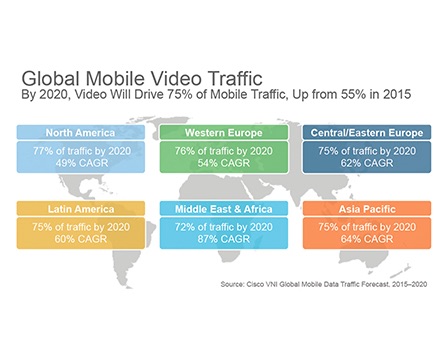It’s a Mobile Video World, After All

Video already eats a small majority of the traffic that flows across mobile networks, but its appetite will become even more voracious in the next five years, per a new study from Cisco Systems.
By 2020, video will comprise more than 75% of the world’s mobile data traffic, up from 55% last year, the networking company found in the Cisco Visual Networking Index (VNI) Global Mobile Data Traffic Forecast (2015 to 2020), its 10th annual study on the topic.
Cisco’s study expects there to be 5.5 billion mobile users by 2020, equal to about 70% of the world’s population.
The technology vendor also believes global mobile-data traffic will reach 30.6 Exabytes per month in 2020, up from 3.7 EB in 2015, and that annual global mobile data traffic will eclipse 366.8 EB in about five years, up from 44.2 EB last year. To put those numbers into perspective, Cisco said 366.8 Exabytes is equal to 81 trillion digital images (28 daily images per person on earth for a year), or 7 trillion video clips from sources like YouTube.
Cisco’s forecast also expects global mobile data traffic to grow two times faster than global fixed Internet-protocol traffic during the next five years.
Notably, all of that mobile traffic is continuing to rise as carriers such as T-Mobile (with Binge On) and Verizon (with FreeBee Data) start to roll out zero-rated and sponsored-data services that focus on video streaming and are exempt from monthly data-usage caps.
The continued growth of mobile phones — including smartphone-tablet hybrids often referred to as “phablets” — will ensure that by 2020, more people will have mobile phones (5.4 billion) than electricity (5.3 billion), running water (3.5 billion) and cars (2.8 billion), Cisco said.
The smarter way to stay on top of broadcasting and cable industry. Sign up below
Cisco’s study also shed more light on the expected growth of WiFi, which has become a key weapon in cable’s wireless arsenal. The study sees global WiFi hotspots, including router-based “home spots,” growing from 64 million in 2015, to 432 million in 2020.
The study also found that, for the first time, monthly WiFi offload traffic, at 3.9 EB, surged past monthly mobile and cellular traffic, at 3.7 EB. That fits in well with cable’s growing cellular backhaul business.
By 2020, WiFi offload traffic’s lead will grow to 38.1 EB of monthly WiFi offload traffic, compared to 30.6 EB for mobile/cellular.
